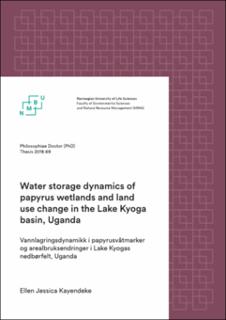| dc.contributor.advisor | French, Helen Kristine | |
| dc.contributor.advisor | Kansiime, Frank | |
| dc.contributor.advisor | Bamutaze, Yazidhi | |
| dc.contributor.advisor | Singh, Bal Ram | |
| dc.contributor.advisor | Øystein, Bjarne Dick | |
| dc.contributor.author | Kayendeke, Ellen Jessica | |
| dc.coverage.spatial | Uganda | en_US |
| dc.date.accessioned | 2020-04-03T13:54:38Z | |
| dc.date.available | 2020-04-03T13:54:38Z | |
| dc.date.issued | 2018 | |
| dc.identifier.isbn | 978-82-575-1537-9 | |
| dc.identifier.issn | 1894-6402 | |
| dc.identifier.uri | https://hdl.handle.net/11250/2650382 | |
| dc.description.abstract | Papyrus wetlands of the upper Nile basin in Eastern Africa provide water and fertile soils that are essential to sustain agricultural production. Due to the need to improve food security, there is increased pressure to convert wetlands into agricultural land. This results in removal of natural wetland vegetation and river diversions and yet the impacts of these changes on wetland functioning and basin wide hydrology are not fully understood.
The thesis objectives were to quantify changes in vegetation productivity and moisture, to assess the water storage dynamics of papyrus wetlands in different seasons, and to identify the key processes of the wetland’s hydrological regime for papyrus wetlands in the Lake Kyoga basin, Uganda.
Time series of MODIS NDVI were classified to create a map of land cover complexes for the study area, and the NDVI trend of each cover complex was analysed using ‘Breaks for Additive Season and Trend’ (BFAST). Vegetation moisture was monitored by calculating Normalised Difference Water Index (NDWI) from Landsat data at 15 year intervals. The bathymetry of a section of the wetland was mapped to estimate the depth-volume relationship, from which water volume was calculated. A profiler rod was used to measure papyrus root mat thickness and depth of the free water column in the dry and wet seasons. Water balance components were calculated using climate, groundwater, wetland stage, and discharge data that were recorded at a selected wetland section.
The results showed that vegetation moisture and productivity have declined and are still declining as a result of land cover changes that occurred more than 15 years ago, since there were no significant land cover changes in the last 15 years. The study also showed that papyrus plants are physically adapted to increasing water levels in the wetlands because their root mat can compress with the pressure of the rising water, which increases the depth of the free water column beneath the plant. These dynamics facilitate an additional storage capacity of 50% in the wet season. Flow in the main wetland channel is the key component (99%) of the papyrus wetland’s hydrological regime implying that the wetland is vulnerable to continued land use changes in the upstream catchment.
Converting wetlands into agricultural land, changes wetland hydrology, leading to reduced moisture availability and productivity in adjacent areas. Because wetlands serve as a boundary for groundwater, their drainage could lead to gradual reduction of the groundwater table over a larger area. Therefore, utilising stored wetland water for irrigation of small-scale farms could be a more sustainable option for improving agricultural productivity. However, further research is needed to understand the impacts of water withdrawal on wetland hydrology. | en_US |
| dc.description.abstract | Papyrus-våtmarker i de øvre delene av Nilens nedbørfelt i Øst-Afrika sikrer vann og fruktbar jord, og er av stor betydning for å opprettholde landbruksproduksjon. På grunn av behovet for å forbedre matsikkerheten, er det økt press for å gjøre om våtmarker til jordbruksarealer. Dette fører til endringer av elveløpet og fjerning av naturlig våtmarksvegetasjon, til tross for at virkningene på våtmarkenes funksjon og nedbørfeltets hydrologi ikke er kjent.
Målene med dette doktorgradsarbeidet er å kvantifisere endringer i vegetasjonens produktivitet og vanninnhold, å kunne analysere papyrusvåtmarkenes sesongmessige vannlagringsdynamikk og å identifisere nøkkelprosesser i papyrusvåtmarkenes hydrologiske regime i Lake Kyogas nedbørfelt, Uganda. | en_US |
| dc.language.iso | eng | en_US |
| dc.publisher | Norwegian University of Life Sciences, Ås | en_US |
| dc.relation.ispartofseries | PhD Thesis;2018:69 | |
| dc.rights | Attribution-NonCommercial-NoDerivatives 4.0 Internasjonal | * |
| dc.rights.uri | http://creativecommons.org/licenses/by-nc-nd/4.0/deed.no | * |
| dc.subject | land cover change | en_US |
| dc.subject | Papyrus root mat | en_US |
| dc.subject | Hydrological regime | en_US |
| dc.title | Water storage dynamics of papyrus wetlands and land use change in the Lake Kyoga basin, Uganda | en_US |
| dc.title.alternative | Vannlagringsdynamikk i papyrusvåtmarker og arealbruksendringer i Lake Kyogas nedbørfelt, Uganda | en_US |
| dc.type | Doctoral thesis | en_US |
| dc.relation.project | NORHED:3303010034 | en_US |

